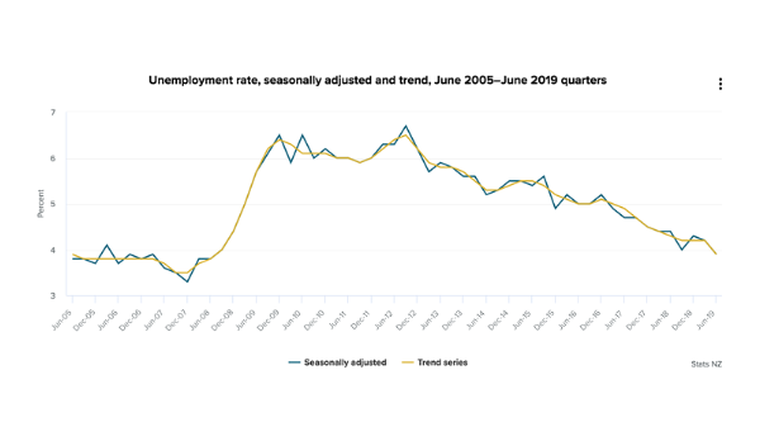Unemployment falls to 11-year low

The seasonally adjusted unemployment rate fell to 3.9 per cent in the June 2019 quarter, down from 4.2 per cent in the March 2019 quarter, said Stats NZ.
This is the lowest unemployment rate since the June 2008 quarter, when it was 3.8 per cent.
The fall in the unemployment rate in the latest quarter reflected a fall in the number of unemployed people, down 7,000, bringing the total number of unemployed to 109,000. This fall was driven by 4,000 fewer unemployed men.
“Labour market data is most useful when placed in the context of a time series. Since late 2012, the seasonally adjusted unemployment rate has largely been tracking down, towards levels seen before the global financial crisis in 2008,” says labour market and household statistics senior manager Sean Broughton.
Māori unemployment falls
The Māori unemployment rate was 7.7 per cent in the June 2019 quarter, down from 9.4 per cent last year. This reflects a decrease in the number of unemployed Māori, down 6,400. At the same time, the number of Māori who were not in the labour force increased, up 14,600.
This is the lowest Māori unemployment rate since the June 2008 quarter, when it was 7.2 per cent.
Underutilisation lowest since 2008
In the June 2019 quarter, the seasonally adjusted underutilisation rate fell to 11.0 per cent, down from 11.3 per cent last quarter. This is the lowest underutilisation rate since the September 2008 quarter, when it was 10.5 per cent.
The underutilisation rate provides a broader measure of spare capacity or slack in New Zealand’s labour market.
For women, the underutilisation rate was 13.0 per cent, down from 13.7 per cent in the March 2019 quarter. This is the lowest underutilisation rate for women since the September 2008 quarter, when it was 12.6 per cent. For men, it was 9.1 per cent, up slightly from 9.0 per cent last quarter.
Overall, the seasonally adjusted number of people who were underutilised fell by 7,000, to 317,000 in the June 2019 quarter. The fall in underutilisation was driven by women (down 9,000), while the number of underutilised men increased (up 2,000).
In the June 2019 quarter, the fall in the number of underutilised women was driven by a fall in the number of women in the potential labour force (down 6,000). This fall occurred alongside falls in the number of unemployed women (down 2,000), and in the number of underemployed women (down 1,000).
“Alongside falls in the unemployment and underutilisation rates, the employment rate has risen. Women fared particularly well, with the second-highest employment rate on record,” says Broughton.
Employment rate up
The seasonally adjusted employment rate rose to 67.7 per cent in the June 2019 quarter, up from 67.5 per cent last quarter.
The employment rate for men rose slightly to 72.4 per cent, up from 72.3 per cent last quarter. For women, the employment rate rose to 63.1 per cent, up from 62.9 per cent.
Annually, 44,100 more people were employed (up 1.7 per cent) – 27,100 more women, and 17,100 more men.





